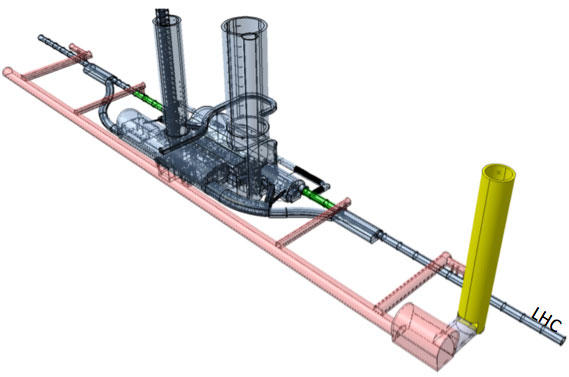Swiss-based international nuclear research organisation CERN calls expressions of interest for design and construction management of new tunnels, shafts, galleries and caverns needed as part of an upgrade program to its particle accelerator, the Large Hadron Collider (LHC).

Procurement for the two design contracts is being fast tracked so that a major part of the underground excavation works can coincide with a planned shutdown of the 27km-long circular particle smasher between 2019 and 2021.
The scope of the construction works, for which a separate procurement process will begin in 2016–17 following 12 months of technical design, includes excavation of two new 100m x 12m diameter shafts, new base caverns for the installation of extra hi-tech machinery, and a total of up to 800m of associated tunnels and galleries that are needed to service critical upgrades to the facility’s already-existing deep-level experimental hall caverns: Atlas and CMS.
John Osborne, head of CERN’s future projects engineering team, told TunnelTalk from Geneva that the excavation contracts form an integral part of what is known as the High Luminosity LHC Project. This is effectively an upgrade to the existing LHC. The new underground structures will enable installation of bulky new machinery that will increase the rate of of particle collisions, called luminosity, recorded by the giant detectors at Atlas and CMS. This will allow a substantial increase in the number of collisions that can be recorded by the detectors, helping scientists in their quest to uncover sub-atomic particles that might one day reveal insights into the hidden secrets of the universe.

“This upgrade project has been in the planning for about five years but the final stage of approval only came through earlier this year,” said Osborne. “The works will be identical at each site: excavation of a 100m deep x 12m diameter shaft with a cavern at the bottom to accommodate cryogenic equipment, plus approximately 400m of galleries and tunnels that connect into the existing LHC ring. Excavation will be by roadheader or rockbreaker.”
The construction procurement schedule is going to be very tight, according to Osborne. “We thought we were going to have more time to do this because the program calls for having the High Luminosity LHC upgrade completed by 2025. However, the physicists are worried that when we actually excavate these new tunnels the works might disrupt the existing beam of the LHC.
“These concerns have changed everything and explain why we now have such a tight schedule. Any work that, potentially, will result in vibration will now need to coincide with the next scheduled shutdown of the LHC.”
The physicists have at least conceded that the risk to ongoing particle studies from vibrations caused by excavation of the shafts, which are set some distance away from the collider itself, is minimal. Work on the shafts is therefore now scheduled to begin in 2017, soon after the construction contracts are awarded. The successful contractor or contractors will not be able to complete the remainder of the scope of contract works (the caverns, tunnels and galleries) until the LHC enters its scheduled shutdown.
Both the Atlas and CMS experiment halls are already serviced by existing shafts, explained Osborne, but the caverns below them house so many large installations that new ones need to be excavated to service the extra underground works and to facilitate the entry of additional equipment during the technical fit out phase. “Using the existing shafts would have been very disruptive to the LHC,” said Osborne.
It has not yet been decided whether the construction contracts will be let separately or as a single contract across the two sites. “A final decision on this has not been taken but I tend to think we will be going for two separate contracts because you have to remember that the CMS site is in France and the Atlas one in Switzerland, and different regulations apply in each of the countries,” explained Osborne. “In our call for expressions of interest we will leave this question open,” he added.
|
|
|
|
|